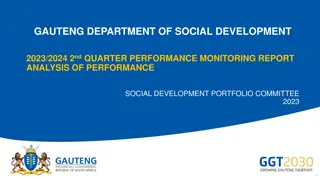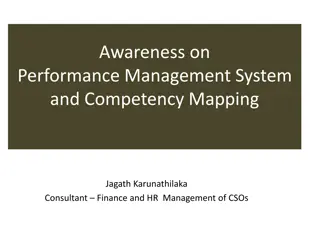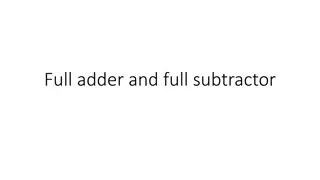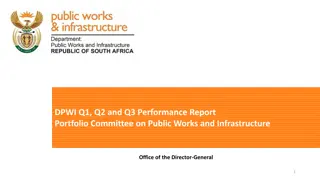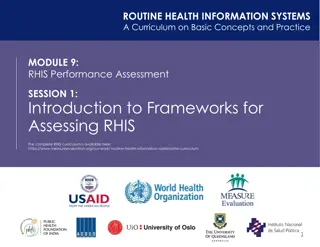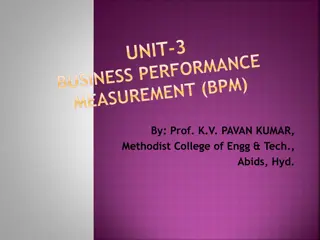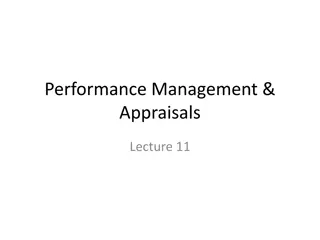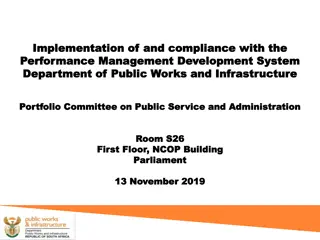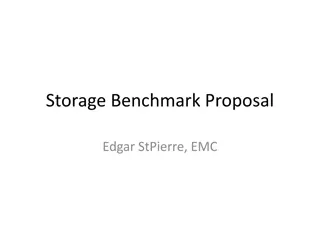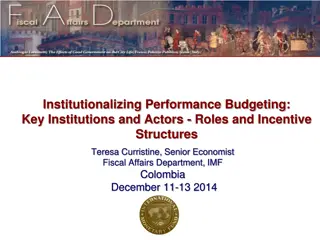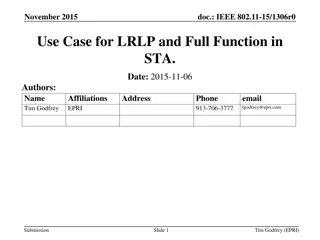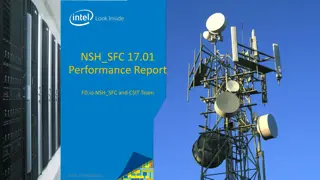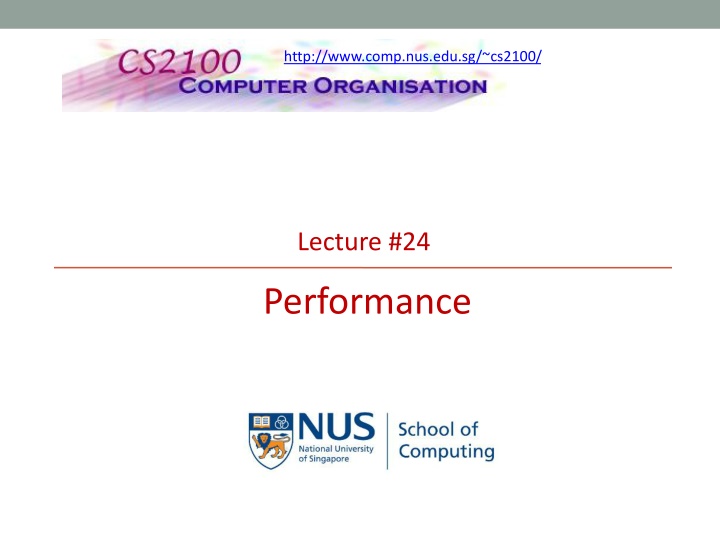
Understanding Performance in Computer Systems
Explore the concept of performance in computer systems through Aaron Tan's lecture, covering topics such as performance definition, factors affecting performance, Amdahl's Law, execution time comparison, refining execution time measurement, clock cycles, and strategies to improve performance.
Download Presentation

Please find below an Image/Link to download the presentation.
The content on the website is provided AS IS for your information and personal use only. It may not be sold, licensed, or shared on other websites without obtaining consent from the author. If you encounter any issues during the download, it is possible that the publisher has removed the file from their server.
You are allowed to download the files provided on this website for personal or commercial use, subject to the condition that they are used lawfully. All files are the property of their respective owners.
The content on the website is provided AS IS for your information and personal use only. It may not be sold, licensed, or shared on other websites without obtaining consent from the author.
E N D
Presentation Transcript
http://www.comp.nus.edu.sg/~cs2100/ Lecture #24 Performance
Aaron Tan, NUS Lecture #24: Performance 2 Lecture #24: Performance 1. Performance Definition 2. Factors Affecting Performance 3. Amdahl s Law
Aaron Tan, NUS Lecture #24: Performance 3 1. Performance: Two Viewpoints Computer X is faster than computer Y is an ambiguous statement Fast can be interpreted in different ways Fast = Response Time The duration of a program execution is shorter Fast = Throughput More work can be done in the same duration We focus on the first viewpoint in this section
Aaron Tan, NUS Lecture #24: Performance 4 1. Execution Time: Comparison Performance is in units of things per second Bigger is better Response time is in number of seconds Smaller is better 1 ????????????= ????? Speedup n, between x and y is ???????????? ???????????? ????? ????? ??????? = =
Aaron Tan, NUS Lecture #24: Performance 5 1. Execution Time: Refining Definition There are different measures of execution time in computer performance: Elapsed time (aka wall-clock time) Counts everything (including disk and memory accesses, I/O, etc.) Not so good for comparison purposes CPU time Doesn t include I/O or time spent running other programs Can be broken up into system time and user time Our focus: User CPU Time Time spent executing the lines of code in the program
Aaron Tan, NUS Lecture #24: Performance 6 1. Execution Time: Clock Cycles Instead of reporting execution time in seconds, we often use clock cycles (basic time unit in machine). seconds cycles seconds Clock = program program cycle Cycle time Cycle time (or cycle period or clock period) Time between two consecutive rising edges, measured in seconds. Clock rate (or clock frequency) = 1 / cycle-time = number-of-cycles/second (unit is Hz; 1 Hz = 1 cycle/second)
Aaron Tan, NUS Lecture #24: Performance 7 1. Execution Time: Version 1.0 seconds program= cycles program seconds cycle Therefore, to improve performance (everything else being equal), you can do the following: Reduce the number of cycles for a program, or Reduce the clock cycle time, or equivalently, Increase the clock rate
Aaron Tan, NUS Lecture #24: Performance 8 Exercise 1: Clock Cycle & Clock Rate Program P runs in 10 seconds on machine A, which has a 400 MHz clock. Suppose we are trying to build a new machine B that will run this program in 6 seconds. Unfortunately, the increase in clock rate has an averse effect on the rest of the CPU design, causing machine B to require 1.2 times as many clock cycles as machine A for the same program. What clock rate should we target at to hit our goal? Answer: Let C be the number of clock cycles required for that program. For A: Time = 10 sec. = C 1/400MHz For B: Time = 6 sec. = (1.2 C) 1/clock_rateB Therefore, clock_rateB = 10 400 1.2/6 MHz = 800 MHz
Aaron Tan, NUS Lecture #24: Performance 9 1. Clock Cycles: Proportional? Each instruction takes n clock cycles An execution consists of I number of instructions Does it mean we need I n cycles to finish it? Number of cycles is proportional to number of instructions? 2nd instruction 3rd instruction 1st instruction 4th 6th 5th ... Clock
Aaron Tan, NUS Lecture #24: Performance 10 1. Clock Cycles: Inst Type Dependent Different instructions take different amount of time to finish: Clock For example: Multiply instruction may take longer than an Add instruction. Floating-point operations take longer than integer operations. Accessing memory takes more time than accessing registers
Aaron Tan, NUS Lecture #24: Performance 11 1. Execution Time: Introducing CPI A given program will require Some number of instructions (machine instructions) average Cycle per Instruction (CPI) Some number of cycles cycle time Some number of seconds We use the average CPI as different instructions take different number of cycles to finish
Aaron Tan, NUS Lecture #24: Performance 12 1. Execution Time: Version 2.0 Average Cycle Per Instruction (CPI) CPI = (CPU time Clock rate) / Instruction count = Clock cycles / Instruction count CPU time = Seconds = Instructions x Cycles x Seconds Program Program Instruction Cycle ? ?? where ??? = ???? ?? ??= Instruction count ??= Instruction frequency ?=1
Aaron Tan, NUS Lecture #24: Performance 13 2. Performance: Influencing Factors Binary executes on Machine Program compiles into Binary Process Compiler ISA Factors Hardware Organization Performance aspects influenced by factors Cycle Time CPI #instructions Average CPI
Aaron Tan, NUS Lecture #24: Performance 14 2. Program Binary: Factors Compiler: Different compilers may generate different binary codes e.g. gnu vs intel c/c++ compiler Different optimization may generate different binary codes e.g. different optimization level in gnu c compiler Instruction Set Architecture: The same high level statement can be translated differently depending on the ISA e.g. same C program under Intel machine vs Sunfire server
Aaron Tan, NUS Lecture #24: Performance 15 Exercise 2: Impact of Compiler Given a program P, a compiler can generate 2 different binaries on a target machine. On that machine, there are 3 classes of instructions: Class A, Class B, and Class C, and they require 1, 2, and 3 cycles respectively. First binary has 5 instructions: 2 of A, 1 of B, and 2 of C. Second binary has 6 instructions: 4 of A, 1 of B, and 1 of C. 1. Which code is faster? By how much? 2. What is the (average) CPI for each code? Answer: Let T be the cycle time. Time(code1) = (2 1 + 1 2 + 2 3) T = 10T Time(code2) = (4 1 + 1 2 + 1 3) T = 9T Time(code1)/Time(code2) = CPI(code1) = CPI(code2) = (4 1 + 1 2 + 1 3) / (4+ 1 + 1) = 1.5 10/9 = 1.1 Code2 is 1.1 times faster (2 1 + 1 2 + 2 3) / (2 + 1 + 2) = 2
Aaron Tan, NUS Lecture #24: Performance 16 2. Execution of Binary Code: Factors Machine More accurately the hardware implementation Determine cycle time and cycle per instruction Cycle Time: Different clock frequencies (e.g. 2GHz vs 3.6GHz) Cycles Per Instruction: Design of internal mechanism (e.g. specific accelerator to improve floating point performance)
Aaron Tan, NUS Lecture #24: Performance 17 Exercise 3: Impact of Machine Suppose we have 2 implementations of the same ISA, and a program is run on these 2 machines. Machine A has a clock cycle time of 10 ns and a CPI of 2.0. Machine B has a clock cycle time of 20 ns and a CPI of 1.2. 1. Which machine is faster for this program? By how much? Answer: Let N be the number of instructions. Machine A: Time = N 2.0 10 ns Machine B: Time = N 1.2 20 ns Performance(A)/Performance(B) = Time(B)/Time(A) = (1.2 20) / (2.0 10) = 1.2
Aaron Tan, NUS Lecture #24: Performance 18 Exercise 4: All Factors (1/4) You are given 2 machine designs M1 and M2 for performance benchmarking. Both M1 and M2 have the same ISA, but different hardware implementations and compilers. Assuming that the clock cycle times for M1 and M2 are the same, performance study gives the following measurements for the 2 designs. For M1 No. of instructions executed 3,000,000,000,000 2,000,000,000,000 2,000,000,000,000 1,000,000,000,000 For M2 No. of instructions executed 2,700,000,000,000 1,800,000,000,000 1,800,000,000,000 900,000,000,000 Instruction class CPI CPI A B C D 1 2 3 4 2 3 3 2
Aaron Tan, NUS Lecture #24: Performance 19 Exercise 4: All Factors (2/4) a) What is the CPI for each machine? Let Y = 1,000,000,000,000 CPI(M1) = (3Y 1 + 2Y 2 + 2Y 3 + Y 4) / (3Y + 2Y + 2Y + Y) = 17Y / 8Y = 2.125 [(3Y 2 + 2Y 3 + 2Y 3 + Y 2) 0.9] / [(3Y + 2Y + 2Y + Y) 0.9] 20Y / 8Y = 2.5 CPI(M2) = = b) Which machine is faster? By how much? Let C be cycle time. Time(M1) = 2.125 (8Y C) Time(M2) = 2.5 (8Y 0.9 C) = 2.25 (8Y C) M1 is faster than M2 by 2.25 / 2.125 = 1.0588
Aaron Tan, NUS Lecture #24: Performance 20 Exercise 4: All Factors (3/4) c) To further improve the performance of the machines, a new compiler technique is introduced. The compiler can simply eliminate all class D instructions from the benchmark program without any side effects. (That is, there is no change to the number of class A, B and C instructions executed in the 2 machines.) With this new technique, which machine is faster? By how much? Let Y = 1,000,000,000,000; Let C be cycle time. CPI(M1) = (3Y 1 + 2Y 2 + 2Y 3) / (3Y + 2Y + 2Y) = 13Y / 7Y = 1.857 [(3Y 2 + 2Y 3 + 2Y 3) 0.9] / [(3Y + 2Y + 2Y) 0.9] 18Y / 7Y = 2.571 CPI(M2) = = Time(M1) = 1.857 (7Y C) Time(M2) = 2.571 (0.9 7Y C) = 2.314 (7Y C) M1 is faster than M2 by 2.314 / 1.857 = 1.246
Aaron Tan, NUS Lecture #24: Performance 21 Exercise 4: All Factors (4/4) d) Alternatively, to further improve the performance of the machines, a new hardware technique is introduced. The hardware can simply execute all class D instructions in zero times without any side effects. (There is still execution for class D instructions.) With this new technique, which machine is faster? By how much? Let Y = 1,000,000,000,000; Let C be cycle time. CPI(M1) = (3Y 1 + 2Y 2 + 2Y 3 + Y 0) / (3Y + 2Y + 2Y + Y) = 13Y / 8Y = 1.625 [(3Y 2 + 2Y 3 + 2Y 3 + Y 0) 0.9] / [(3Y + 2Y + 2Y + Y) 0.9] 18Y / 8Y = 2.25 CPI(M2) = = Time(M1) = 1.625 (8Y C) 2.25 (0.9 8Y C) = 2.025 (8Y C) Time(M2) = 2.025 / 1.625 = 1.246 M1 is faster than M2 by
Aaron Tan, NUS Lecture #24: Performance 22 Summary: Key Concepts Performance is specific to a particular program on a specific machine Total execution time is a consistent summary of performance For a given architecture, performance increase comes from: Increase in clock rate (without adverse CPI effects) Improvement in processor organization that lowers CPI Compiler enhancement that lowers CPI and/or instruction count Pitfall: Expecting improvement in one aspect of a machine s performance to affect the total performance.
Aaron Tan, NUS Lecture #24: Performance 23 3. Amdahl s Law (1/3) Pitfall: Expecting the improvement of one aspect of a machine to increase performance by an amount proportional to the size of the improvement. Example: Suppose a program runs in 100 seconds on a machine, with multiply operations responsible for 80 seconds of this time. How much do we have to improve the speed of multiplication if we want the program to run 4 times faster? 100 (total time) = 80 (for multiply) + UA (unaffected) UA = 20 100/4 (new total time) = Speedup = 80/5 = 16 80/Speedup (for multiply) + UA
Aaron Tan, NUS Lecture #24: Performance 24 3. Amdahl s Law (2/3) Example (continued): How about making it 5 times faster? 100 (total time) = 80 (for multiply) + UA (unaffected) 100/5 (new total time) = Speedup = 80/0 = ??? (impossible!) 80/Speedup (for multiply) + UA There is no way we can enhance multiply to achieve a fivefold increase in performance, if multiply accounts for only 80% of the workload.
Aaron Tan, NUS Lecture #24: Performance 25 3. Amdahl s Law (3/3) Amdahl s law: Performance is limited to the non-speedup portion of the program Execution time after improvement = Execution time of unaffected part + (Execution time of affected part / Speedup) Corollary of Amdahl s law: Optimize the common case first!
Aaron Tan, NUS Lecture #24: Performance 26 Exercise 5: Amdahl s Law Suppose we enhance a machine making all floating-point instructions run five times faster. If the execution time of some benchmark before the floating-point enhancement is 12 seconds, what will the speedup be if half of the 12 seconds is spent executing floating-point instructions? Time = 6 (UA) + 6 (fl-pt) / 5 = 7.2 sec. Speedup = 12 / 7.2 = 1.67
Aaron Tan, NUS Lecture #24: Performance 27 Exercise 6: Amdahl s Law We are looking for a benchmark to show off the new floating-point unit described in the previous example, and we want the overall benchmark to show a speedup of 3. One benchmark we are considering runs for 100 seconds with the old floating-point hardware. How much of the execution time would floating-point instructions have to account for in this program in order to yield our desired speedup on this benchmark? Speedup = 3 = 100 / (Time_fl / 5 + 100 Time_fl) 83.33 sec. Time_FI =
Aaron Tan, NUS Lecture #24: Performance 28 End of File






